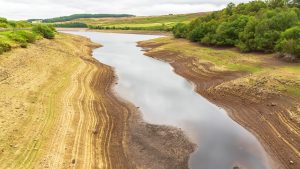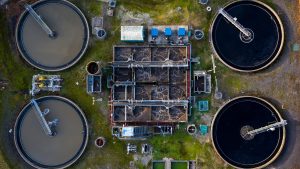The Innovation Platform spoke to Marc Hannis, Principal of Ofwat’s Water Innovation Fund, about the impacts of climate change on the water cycle.
Climate change is one of the world’s biggest challenges and will have a substantial and lasting impact on the water cycle. Major impacts of climate change on the water cycle include changing rainfall patterns that could increase the risk of drought and surface water and sewer flooding. Climate change may exacerbate the damage caused by overflows of untreated wastewater into the environment. This is a serious problem – the UK needs a reliable water cycle.
Established in 1989, Ofwat is a non-ministerial government department aiming to improve the environment and life through water. Ofwat recognises the importance of mitigating the impacts of climate change on the water sector and believes that not only should the sector adapt to the impacts of climate change, but should also adapt its practices to meet the challenge of net zero. In a drive to grow the water sector’s capacity to innovate, Ofwat established a £200m Water Innovation Fund in 2020. The scheme delivers a series of competitions open to water companies who are encouraged to innovate around Ofwat’s strategic themes. To find out more, The Innovation Platform spoke to Marc Hannis, Principal of Ofwat’s Water Innovation Fund.
How does Ofwat support the water sector to protect the environment?
A healthy, functioning environment is crucial for the water sector to deliver the services and outcomes needed by people, society, and the environment.
We believe we have a shared responsibility to protect people and the natural world; from preserving precious water supplies, helping customers and communities, to protecting and enhancing wildlife.
While the Environment Agency is the main body responsible for regulating water quality and ecological protection, Ofwat plays a critical role in driving and enabling the water sector to protect and improve the environment.
The sector is reliant on a predictable and sustainable hydrological system or water cycle. Multiple pressures including population growth, climate change, and the desire to reduce water abstraction mean the sector has to be more flexible, resilient, and innovative.
That means water companies tackling storm overflows of excess rainwater that divert sewage into waterways, continuing to drive down the volume of water lost to leaks in 347,636km of water mains, and maintaining and upgrading infrastructure to prevent wastewater spillage in the 571,434km of sewer pipes.
It also means playing an active role in the transition to a net zero economy. The water cycle sector is vulnerable to the impacts of climate change – whether that is unpredictable rainfall in drought, deluges resulting in an overwhelmed sewage system, or river health and biodiversity coming under threat from a heating planet.
Ofwat also recognises the sector’s contribution to atmospheric greenhouse gasses. A significant amount of energy is used to pump water to homes and transport wastewater to treatment centres – around 2-3% of all electricity in the UK is used by the water sector. For this reason, the sector has set itself the ambition of being net zero by 2030.
In 2021, Ofwat launched a £200m innovation fund to incentivise new initiatives and technologies that align with our four innovation themes and accelerate the move to a net zero and environmentally sustainable future for the water industry and its customers. The four themes are:
- Adapting to climate change and achieving net zero emissions;
- Protecting and enhancing the environment;
- Delivering long-term operational resilience; and
- Improving the delivery of services for customers and society.
The Innovation Fund has just completed its pilot year. In that time, it has awarded £63m to projects. They include bio-engineering solutions for ammonia and phosphorus pollution to remove pollutants from water whilst creating a circular economy for finite and useful chemicals. There are carbon capture initiatives to cut industry-related emissions to meet water industry targets of achieving net zero emissions by 2030. There are also cutting-edge research projects to develop green hydrogen from sewage, to create clean energy alternatives for the future.
We are excited to announce that a third Water Breakthrough Challenge will launch in autumn 2022 and will award up to £38m to innovative projects from partnerships led by water companies. We will also be launching a new £4m ‘open access competition’ which will be open to innovators from any sector without the need to partner with a water company.

© iStock/ Anne
Climate change is a major challenge faced by the water sector. What are the biggest implications of climate change on the long-term sustainability of the water and sewage sectors?
We are reliant on a stable and predictable hydrological cycle. The water in someone’s tap fell to the ground as rain, has been captured in reservoirs, abstracted from rivers, or pumped from the ground. When it goes down the drain or is flushed down the toilet, it enters a wastewater system that also captures rainwater with a finite capacity.
The sector needs to adapt to the consequences of climate change, but also adapt its practices to make sure it is no longer a net contributor of greenhouse gasses.
Climate change is impacting the predictability of weather enormously. In the UK, we think of ourselves as a rainy country, but we are becoming more prone to drought. That means less rain replenishing aquifers (water sources held beneath the ground), reservoirs not being filled to capacity, and tributaries to major rivers running dry. This is only going to become more common.
At the same time, demand for water could outstrip supply as the population increases and more houses are built. The Environment Agency has warned that the UK may not have enough water to meet demand by the middle of the century.
When we do get rain, it is increasingly coming in the form of severe storms dumping more water than the drainage and sewage network is designed to cope with. The consequence is that, during these capacity-bursting storms, wastewater can overflow into rivers and streams, causing pollution and environmental damage.

© iStock/Teamjackson
A number of winners in the Water Breakthrough Challenges are delivering innovations to tackle the issue:
Artificial Intelligence of Things Enabling Autonomous Waste Catchments is a cross-sector coalition, led by Severn Trent Water – with partners including Microsoft, BT, the National Cyber Security Centre, and the University of Exeter – to pilot the use of Artificial Intelligence that monitors a waste catchment area in real-time, minimising the risk of flooding and sewage pollution. With the water industry accounting for 35% of river pollution, the project has received around £2m to develop new and integrated approaches for spill prevention.
Sub-Seasonal Forecasting to Improve Operational Decision Making – led by Thames Water – was a winner of the second Water Breakthrough Challenge. The project will create a reliable weather impact modelling and forecasting system which will help water companies forecast weather events beyond 10-14 days, up to four to six weeks ahead. These systems will improve water companies’ understanding of how the weather impacts their water and wastewater management. Using these systems will improve their resourcing and operational management capabilities for areas at risk from severe weather events, for example, rapid changes in customer demand for water and regions which are prone to surface water flooding.
Enabling Smart Water Communities is a group of water companies, universities, home builders, and local authorities that will work together to ensure that the four million new homes planned by 2041 can be integrated into the water cycle in a sustainable way, ensuring new communities have continued access to finite water resources, wastewater is managed, and flood risks are mitigated.
Can you explain the importance of Ofwat’s investigation into sewage works? What progress has been made so far?
The investigation is the largest ever undertaken by Ofwat in terms of scale. In November 2021, Ofwat announced investigations into all wastewater companies in England and Wales. This was after new data emerged suggesting companies may not be treating as much sewage at their wastewater treatment works as they should be, and that this could be resulting in sewage discharges into the environment at times when this should not be happening. While the Environment Agency is investigating potential breaches of environmental law it is responsible for enforcing, Ofwat is looking at companies’ compliance with their statutory duty to provide a wastewater treatment system, along with related licence obligations.
We received responses from companies at the beginning of 2022, and our initial assessment of those responses led to Ofwat opening enforcement cases in March against Anglian Water, Northumbrian Water, Thames Water, Wessex Water, and Yorkshire Water. Additional information and ongoing concerns led to an enforcement case also being opened against South West Water in June, meaning that we have now opened enforcement cases against the majority of wastewater companies in England and Wales. From what we have seen so far, the scale of the issues appears significant – companies must resolve any problems at wastewater treatment works and do so quickly. Where they have breached their obligations, we will not hesitate to act.

©iStock/BrianAJackson
As the investigation continues, we expect all companies to make quick progress to address any non-compliance and strengthen the management of their environmental obligations as a whole. More information on the investigation, including what we have heard from companies so far, can be found on our website.
Can you explain more about the Ofwat Innovation Fund and its aims? Can you provide an example of how the winners are working to address the challenges of climate change for the water cycle sector?
People might not think of water as an energy-intensive or emitting industry, but it is. Water is heavy – it needs to be pumped at enormous volumes to ensure you can turn the tap on, run the shower, or flush the toilet without having to worry whether there will be a supply or not. Transporting and cleaning wastewater also requires lots of energy. 2-3% of the country’s electricity is estimated to go on keeping the water sector functioning, yet the water sector is particularly susceptible to the impacts of climate change.
Through the Innovation Fund, we have been able to fund some really exciting projects that help towards the sector’s net zero goal: some high-tech, some nature-based, some focused on creating sustainable energy alternatives, and some using bio-engineering solutions.
CECCU (CHP Exhaust Carbon Capture and Utilisation) is a project to turn captured carbon into useful products like paint and fertiliser, saving five million tonnes of CO2 per year and making the combined heat and power (CHP) process – where heat as a by-product of energy generated is captured and used – carbon neutral.
One of the biggest sources of greenhouse gas emissions from the water industry is nitrous oxide – 300 times more potent than carbon dioxide. Catalysing a NET-ZERO future is using bacteria to remove toxic ammonia in our existing wastewater treatment processes. It is produced by bacteria that play a vital role in removing toxic ammonia from wastewater. If ammonia is not removed, it damages aquatic life. Recently, researchers have identified naturally occurring bacteria that can remove ammonia without producing nitrous oxide, but these do not ordinarily thrive in treatment plants. This project will develop innovative techniques for capturing these game-changing bacteria and putting them to work in our existing treatment processes.
Seagrass Seeds of Recovery will provide a blueprint for the restoration of seagrass in the UK, creating opportunities for biodiversity improvements and carbon and nitrogen reduction. Seagrass meadows enhance the stability of the coastal zone, locking carbon into the seabed, improving water quality, and creating a habitat for small animals, which enhances the resilience of coastal ecosystems. The project will provide a roadmap to unlock the ‘blue carbon’ potential (carbon captured by marine ecosystems) of seagrass restoration for the water industry and beyond.
Anglian Water’s Triple Carbon Reduction solution was awarded more than £3.5m in the first Water Breakthrough Challenge to reduce wastewater-associated greenhouse gas emissions and use sewage as a new source of hydrogen. It aims to deliver three significant reductions in climate-change-causing gases by using an innovative membrane technology known as a ‘Membrane Aerated Biofilm Reactor’ to clean used water. ‘Triple Carbon Reduction’ is so-called as it aims to cut greenhouse gasses in three different ways. Firstly, the technology uses less power than traditional systems, reducing its power-related emissions. Secondly, it reduces the amount of nitrous oxide released into the atmosphere (a greenhouse gas 300 times more powerful than carbon dioxide). Thirdly, it aims to produce a new, low carbon source of hydrogen that can be used to generate, store, and transport renewable energy at scale.
To find out more about Ofwat’s Innovation Fund and how to enter future competitions, visit:https://waterinnovation.challenges.org
Marc Hannis
Principal
Ofwat’s Water Innovation Fund
www.ofwat.gov.uk/
https://www.linkedin.com/in/marc-hannis-66b97732/?originalSubdomain=uk
Please note, this article will also appear in the eleventh edition of our quarterly publication.



